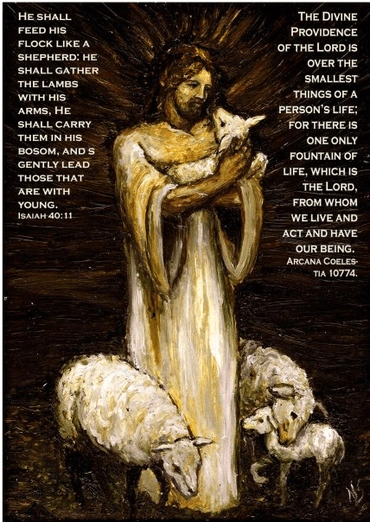43. And having turned I saw seven golden lampstands. This symbolizes a new church, which will have an enlightenment from the Lord from the Word.
We are told in the last verse of this chapter that the seven lampstands are the seven churches, and it may be seen in no. 10 above that the seven churches mean all in the Christian world who turn to the church - and this in every case according to each one's state of reception (no. 41).
The seven lampstands mean a new church because the Lord is in it and in the midst of it. For we are told that in the midst of the seven lampstands John saw one like the Son of Man, and the Son of Man means the Lord in relation to the Word.
The lampstands appeared golden, because gold symbolizes goodness, and every church is a church by virtue of the goodness that is formed through truths. That gold symbolizes goodness will be seen in subsequent explanations.
[2] These lampstands were not next to one another or placed so as to touch each other, but stood at some intervals forming a kind of circle, as it apparent from this statement in the following chapter,
These things says He who... walks in the midst of the seven golden lampstands. (Revelation 2:1)
We are not told anything about the lamps on the lampstands, but later it is said that the Holy Jerusalem, which is to say, the New Church, "has no need of the sun or of the moon," because "its lamp is the Lamb, and the nations that are saved shall walk in its light" (Revelation 21:23-24). And furthermore,
They need no lamp..., for the Lord God gives them light. (Revelation 22:5)
For those people who will be constituents of the Lord's New Church are the only "lampstands" that will shine with light from the Lord.
[3] The golden lampstand in the Tabernacle represented nothing else than the church in relation to its enlightenment by the Lord. Regarding this lampstand, see Exodus 25:31-40; 37:17-24; 26:35, Numbers 8:2-4. That it represented the Lord's church as to Divine spiritual love, which is love for the neighbor, see Arcana Coelestia (The Secrets of Heaven), nos. 9548, 9555, 9558, 9561, 9570, 9783. See also no. 493 below.
The lampstand in Zechariah 4 also symbolizes a new church to be established by the Lord, since it symbolizes a new house of God or temple, as is apparent from what follows there; and a house of God or temple symbolizes the church, and in the highest sense, the Lord's Divine humanity, as He Himself teaches in John 2:19-21, 1
and elsewhere.
But we will say what in turn is symbolically meant in Zechariah 4, when the lampstand appeared to him:
The particulars contained in verses 1-7 symbolize the Lord's enlightenment of a new church from the goodness of love by means of truth. The olive trees there symbolize the church in regard to the goodness of love.
The particulars from 8-10 verse there mean, symbolically, that the enlightenment comes from the Lord. Zerubbabel there, who is to build the house, thus the church, represents the Lord.
The particulars from verse 11-14 mean, symbolically, that that the church will also have in it truths from a heavenly origin.
This explanation of that chapter was given to me by the Lord through heaven.
Footnotes:







